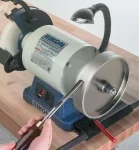Advantages and Parameters of Double-Sided Grinding and Polishing Machine
Introduction:
In recent years, with the continuous development of technology, the demand for high-precision and high-quality products has increased significantly. This has led to the rapid development and widespread use of double-sided grinding and polishing machines. These machines are widely used in various industries, such as optics, semiconductor, and electronics. This article aims to discuss the advantages and parameters of double-sided grinding and polishing machines.
Advantages of Double-Sided Grinding and Polishing Machines:
1. Increased Efficiency: One of the significant advantages of double-sided grinding and polishing machines is their ability to process both sides of a workpiece simultaneously. This dual-sided processing significantly improves the efficiency of the grinding and polishing process, reducing the overall production time.
2. Enhanced Precision: Double-sided grinding and polishing machines provide precise and uniform results due to the simultaneous processing of both sides of the workpiece. This ensures consistent thickness, parallelism, and flatness, which are essential for achieving high-quality finished products.
3. Versatility: These machines are highly versatile and can be used for a wide range of materials, including metals, ceramics, glass, and crystals. They are also suitable for various shapes, such as plates, discs, and irregular forms, making them adaptable to different manufacturing requirements.
4. Cost-Effective: By combining two processes into one, double-sided grinding and polishing machines save both time and labor costs. The reduced production time and increased efficiency result in lower production costs, making these machines a cost-effective solution for manufacturers.
Parameters of Double-Sided Grinding and Polishing Machines:
1. Workpiece Size: The maximum and minimum dimensions of the workpiece that can be processed by the machine play a crucial role in determining its applicability. Different models of double-sided grinding and polishing machines have varying workpiece size capacities, ranging from small-scale applications to large-scale industrial production.
2. Grinding Wheel Diameter: The size of the grinding wheel determines the grinding area and the depth of material removal. Larger grinding wheels provide a larger processing area and can remove more material in a single operation. However, the choice of grinding wheel diameter depends on the specific requirements of the workpiece and the desired surface finish.
3. Speed Control: The speed at which the workpiece rotates and the grinding wheels rotate affects the material removal rate and the surface finish. Double-sided grinding and polishing machines have adjustable speed settings to accommodate different materials, workpiece sizes, and desired results. Precise speed control ensures optimal processing conditions and prevents damage to the workpiece.
4. Pressure Control: The amount of pressure applied during the grinding and polishing process affects the material removal rate, surface finish, and overall quality of the finished product. Double-sided grinding and polishing machines typically have adjustable pressure settings to provide flexibility according to the specific requirements of the workpiece.
Conclusion:
Double-sided grinding and polishing machines offer numerous advantages for manufacturers, including increased efficiency, enhanced precision, versatility, and cost-effectiveness. The parameters of these machines, such as workpiece size, grinding wheel diameter, speed control, and pressure control, play crucial roles in determining their applicability and performance. As technology advances further, double-sided grinding and polishing machines are expected to become even more efficient and versatile, catering to the evolving needs of various industries.
.webp)
